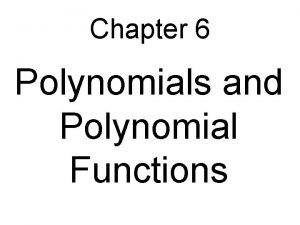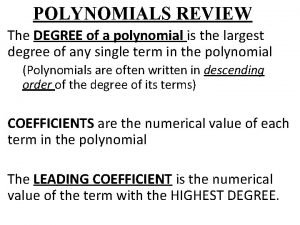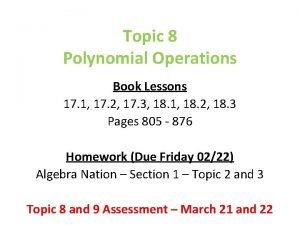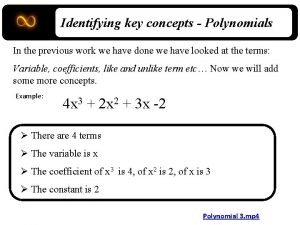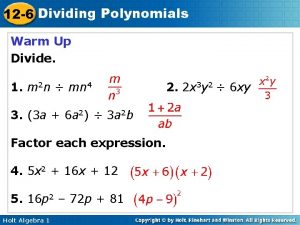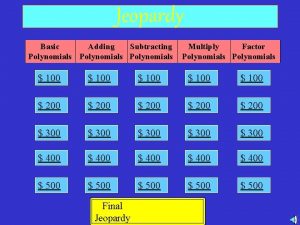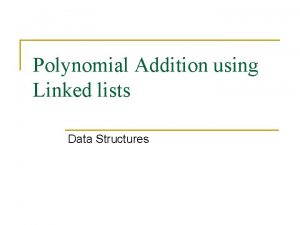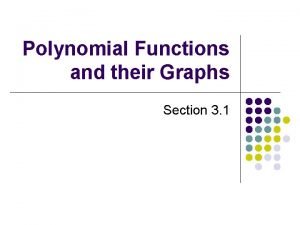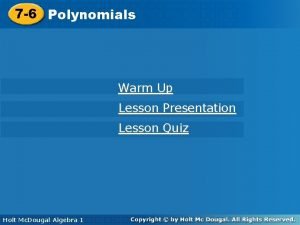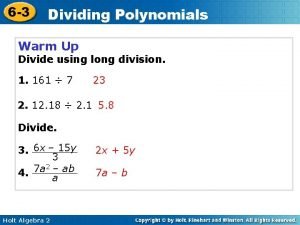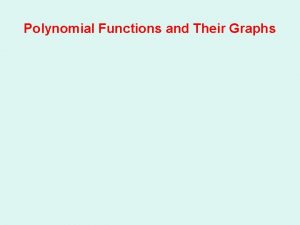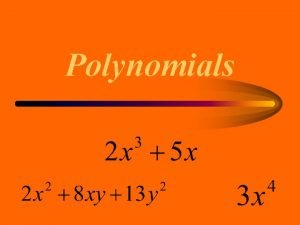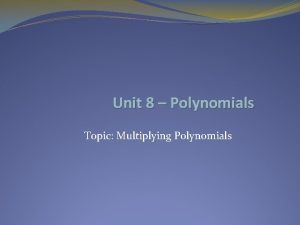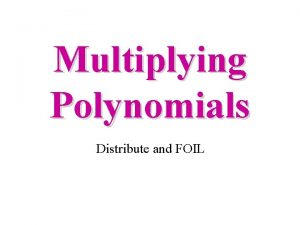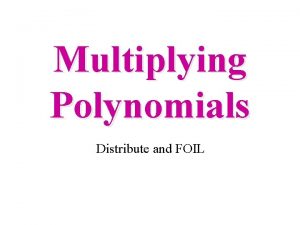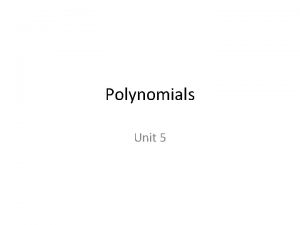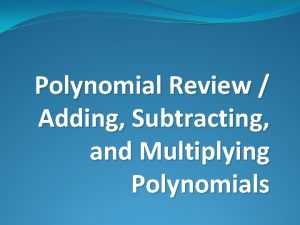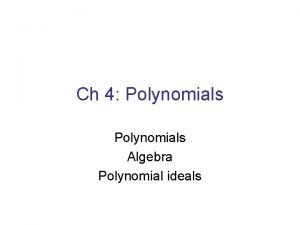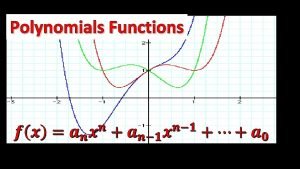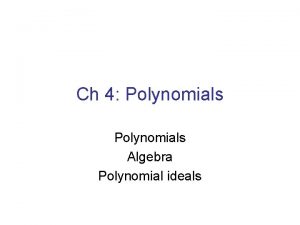Polynomials What is a polynomial A polynomial in














- Slides: 14

Polynomials!

What is a polynomial? A polynomial in one variable is any expression that can be written in the form anxn + an-1 xn-1 + ··· + a 1 x 1 + a 0 Where x is a variable, the exponents are nonnegative integers, the coefficients are real numbers, and an ≠ 0. Each monomial being added to make the polynomial is a term.

What does that mean? • • Exponents of variables can’t be negative (4 x-2) Exponents of variables can’t be fractions (4 x 1/2) No taking the root of variables (4√x) Coefficients have to be real numbers No dividing by variables (4/x) The pieces between plus signs are called terms In standard form, terms are written in order from biggest degree to smallest degree

Let’s practice: with your seat-partner, determine which are polynomials and label them 1 2 3 5 x 2 + 4 4 x - √ 9 Polynomial, two terms, binomial, 2 nd degree binomial, 1 st degree 4 - √x Not a polynomial 4 5 6 4 x 6 + 12 x 4 - 3 Polynomial, three terms, trinomial, 6 th degree 6 x 9 + (4/x) – 10 Not a polynomial 5 x 4 + 12 x 9 + 10 x 5 – x Polynomial, four terms, 9 th degree 7 8 9 16 x-4 + x – 8 Not a polynomial (6 x + 3)(4 x – 12) 24 x 2 + 84 x - 36 Polynomial, have to multiply it out to see 3 terms, trinomial, 2 nd degree 168 Polynomial, one term, monomial, 0 th degree

Let’s practice: with your seat-partner, determine which are polynomials and label them 1 2 3 5 x 2 + 4 4 x - √ 9 Polynomial, two terms, binomial, 2 nd degree binomial, 1 st degree 4 - √x Not a polynomial 4 5 6 4 x 6 + 12 x 4 - 3 Polynomial, three terms, trinomial, 6 th degree 6 x 9 + (4/x) – 10 Not a polynomial 5 x 4 + 12 x 9 + 10 x 5 – x Polynomial, four terms, 9 th degree 7 8 9 16 x-4 + x – 8 Not a polynomial (6 x + 3)(4 x – 12) 24 x 2 + 84 x - 36 Polynomial, have to multiply it out to see 3 terms, trinomial, 2 nd degree 168 Polynomial, one term, monomial, 0 th degree

How do we talk about polynomials? • One thing we talk about with polynomials is how many terms they have • Monomial means 1 term: 4 x 2 • Binomial means 2 terms: 4 x 2 – 4 • Trinomial means 3 terms: 4 x 2 + 4 x – 4 • Polynomial means many terms: 4 x 5 + 4 x 4 + 4 x 3 + 4 x 2 + 4 x + 4

Let’s practice: with your seat-partner, write down how many terms each polynomial has, and label monomials, binomials, and trinomials 1 2 3 5 x 2 + 4 4 x - √ 9 Polynomial, two terms, binomial, 2 nd degree binomial, 1 st degree 4 - √x Not a polynomial 4 5 6 4 x 6 + 12 x 4 - 3 Polynomial, three terms, trinomial, 6 th degree 6 x 9 + (4/x) – 10 Not a polynomial 5 x 4 + 12 x 9 + 10 x 5 – x Polynomial, four terms, 9 th degree 7 8 9 16 x-4 + x – 8 Not a polynomial (6 x + 3)(4 x – 12) 24 x 2 + 84 x - 36 Polynomial, have to multiply it out to see 3 terms, trinomial, 2 nd degree 168 Polynomial, one term, monomial, 0 th degree

Let’s practice: with your seat-partner, write down how many terms each polynomial has, and label monomials, binomials, and trinomials 1 2 3 5 x 2 + 4 4 x - √ 9 Polynomial, two terms, binomial, 2 nd degree binomial, 1 st degree 4 - √x Not a polynomial 4 5 6 4 x 6 + 12 x 4 - 3 Polynomial, three terms, trinomial, 6 th degree 6 x 9 + (4/x) – 10 Not a polynomial 5 x 4 + 12 x 9 + 10 x 5 – x Polynomial, four terms, 9 th degree 7 8 9 16 x-4 + x – 8 Not a polynomial (6 x + 3)(4 x – 12) 24 x 2 + 84 x - 36 Polynomial, have to multiply it out to see 3 terms, trinomial, 2 nd degree 168 Polynomial, one term, monomial, 0 th degree

What degree is it? • Another way we classify polynomials is by the degree of the polynomial • This is determined by the highest power an exponent has • 0 th degree: 658 x 0 Normally written: 658 • 1 st degree: 4 x 1 + 1 Normally written: 4 x + 1 • 2 nd degree: 4 x 2 + 1 • 3 rd degree: 4 x 3 + 5 x 2 + 1 • And so on

Let’s practice: with your seat-partner, write down the degree of each polynomial 1 2 3 5 x 2 + 4 4 x - √ 9 Polynomial, two terms, binomial, 2 nd degree binomial, 1 st degree 4 - √x Not a polynomial 4 5 6 4 x 6 + 12 x 4 - 3 Polynomial, three terms, trinomial, 6 th degree 6 x 9 + (4/x) – 10 Not a polynomial 5 x 4 + 12 x 9 + 10 x 5 – x Polynomial, four terms, 9 th degree 7 8 9 16 x-4 + x – 8 Not a polynomial (6 x + 3)(4 x – 12) 24 x 2 + 84 x - 36 Polynomial, have to multiply it out to see 3 terms, trinomial, 2 nd degree 168 Polynomial, one term, monomial, 0 th degree

Let’s practice: with your seat-partner, write down the degree of each polynomial 1 2 3 5 x 2 + 4 4 x - √ 9 Polynomial, two terms, binomial, 2 nd degree binomial, 1 st degree 4 - √x Not a polynomial 4 5 6 4 x 6 + 12 x 4 - 3 Polynomial, three terms, trinomial, 6 th degree 6 x 9 + (4/x) – 10 Not a polynomial 5 x 4 + 12 x 9 + 10 x 5 – x Polynomial, four terms, 9 th degree 7 8 9 16 x-4 + x – 8 Not a polynomial (6 x + 3)(4 x – 12) 24 x 2 + 84 x - 36 Polynomial, have to multiply it out to see 3 terms, trinomial, 2 nd degree 168 Polynomial, one term, monomial, 0 th degree

Standard form? • Polynomials are said to be in “standard form” if they are in order from the highest degree term to the lowest. • In standard form • x 4 + x 3 + x 2 + x 1 + x + n • Not in standard form • x 3 + x 4 + x 1 + x 2 + n + x

Let’s practice: with your seat-partner, write down which polynomials are in standard form, and which are not 1 2 3 5 x 2 + 4 4 x - √ 9 Polynomial, two terms, binomial, 2 nd degree binomial, 1 st degree 4 - √x Not a polynomial 4 5 6 4 x 6 + 12 x 4 - 3 Polynomial, three terms, trinomial, 6 th degree 6 x 9 + (4/x) – 10 Not a polynomial 5 x 4 + 12 x 9 + 10 x 5 – x Polynomial, four terms, 9 th degree 7 8 9 16 x-4 + x – 8 Not a polynomial (6 x + 3)(4 x – 12) 24 x 2 + 84 x - 36 Polynomial, have to multiply it out to see 3 terms, trinomial, 2 nd degree 168 Polynomial, one term, monomial, 0 th degree

Let’s practice: with your seat-partner, write down which polynomials are in standard form, and which are not 1 standard 2 standard 5 x 2 + 4 4 x - √ 9 Polynomial, two terms, binomial, 2 nd degree binomial, 1 st degree 4 standard 4 x 6 + 12 x 4 - 3 Polynomial, three terms, trinomial, 6 th degree 7 16 x-4 + x – 8 Not a polynomial 5 6 x 9 + (4/x) – 10 Not a polynomial 8 not standard (6 x + 3)(4 x – 12) 24 x 2 + 84 x - 36 Polynomial, have to multiply it out to see 3 terms, trinomial, 2 nd degree 3 4 - √x Not a polynomial 6 not standard 5 x 4 + 12 x 9 + 10 x 5 – x Polynomial, four terms, 9 th degree 9 standard 168 Polynomial, one term, monomial, 0 th degree
 End behavior of a function chart
End behavior of a function chart Degree 5 graph
Degree 5 graph Numpy.polynomial.polynomial
Numpy.polynomial.polynomial How to divide a polynomial by another polynomial
How to divide a polynomial by another polynomial Polynomial closure property
Polynomial closure property Dividing polynomials math lib
Dividing polynomials math lib Polynomial factoring rules
Polynomial factoring rules Dividing polynomials by binomials
Dividing polynomials by binomials Adding and subtracting polynomials jeopardy
Adding and subtracting polynomials jeopardy Polynomial addition in data structure
Polynomial addition in data structure Constant polynomial
Constant polynomial Writing polynomials in standard form
Writing polynomials in standard form Lesson 6-5 dividing polynomials
Lesson 6-5 dividing polynomials What is a leading term in polynomials
What is a leading term in polynomials Multiplying polynomials vocabulary
Multiplying polynomials vocabulary
